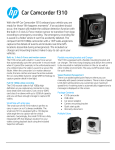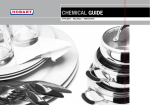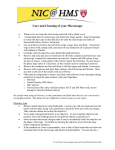Transcript
CHAINSAW CYLINDER & PISTON REPLACEMENT The Basics Foreign contaminants, incorrect assembly techniques or failure to identify the real reason why an engine failed in the first place are the most common causes of failures of new internal engine components that are returned for warranty. Preparation Cleanliness: there is a reason why all Formula One and V8 Supercar teams have spotless engine assembly rooms with floors and benches that you could eat your lunch off, they want their engine rebuilds to perform and last and so should you. Clean the chainsaw, your tools and the work bench area thoroughly before attempting any internal engine maintenance. During disassembly ensure that no dirt or foreign particles can fall into the crankcase. Identify how the Chainsaw Failed You have now identified that the cylinder and piston requires replacing, the saw is now clean and ready for dismantling but do you actually know why the saw failed? It is pointless to fit a new cylinder and piston assembly if you have not identified why the original one failed in the first place! It may not have just been run on a lean mixture or straight fuel, now while the saw is clean is your chance to have a good look around. a) What position are the carburettor screws set at? (most carburettor are set too lean, reset the high and low speed screws now to basic settings of 1 1/2 turns out from seated to avoid forgetting later on!) b) Is there a broken anti-vibe rubber that has caused the inlet elbow to stretch and crack, causing the saw to lean out? c) Has the impulse line split or come off? d) Is the cylinder base gasket still in one piece? e) Is the cylinder loose? f) Have you tested the crankshaft seals, are they leaking? There are many causes of cylinder failures some can be checked before disassembly and others will need to be identified after disassembly. Dismantling Since there are many different saws on the market all with slightly different disassembly requirements we are only going to cover the basics here, you should consult your relevant saw manufacturers service manuals for full instructions. 1. Remove the cylinder cover, spark plug, carburettor and muffler etc. 2. Undo the four cylinder mounting bolts and carefully lift up and remove the cylinder—it is absolutely critical at this point to ensure that no dirt or foreign particles fall into the crankcase. 3. Cover up the crankcase opening with a clean cloth or paper towel. 4. Remove the gudgeon pin circlips from the piston and push out the gudgeon pin to remove the piston. 5. Check the condition of little end bearing and replace if necessary. 6. Remove the old cylinder base gasket and thoroughly clean the mating surface. Inspection Check the failed cylinder and piston for more telltale signs of what led to the failure. Score marks on the piston can indicate: a) Incorrect carburettor setting—maximum speed set too high. b) Incorrect oil / fuel mixture ratio (or incorrect oil / no oil in fuel) c) Poor quality fuel / stale low octane Excessive carbon build up can indicate: a) Incorrect carburettor setting—maximum speed set too low. b) Incorrect oil / fuel mixture ratio (or incorrect oil / too much oil in fuel) Piston Ring broken can indicate: a) Excessive engine speed. b) Oversized piston ring groove. c) Piston ring worn out. Assembly Instructions 1. Make sure that your hands are clean, also ensure that all new components are clean— wash them in clean two stroke fuel prior to assembly. 2. Lubricate the small end bearing with clean two stroke oil and install into the connecting rod. 3. Refit the new piston assembly with the arrow facing towards the exhaust port, lubricate the gudgeon pin with clean two stroke oil and gently slide into place (note the gudgeon pin should slide into place by hand once lubricated, do not use pliers or a hammer to fit and do not install dry.) 4. Ensure that both gudgeon pin circlips are installed with their ends pointing vertically. (Important: never install circlips horizontally otherwise they could compress and come out causing engine failure.) 5. Remove the towel from the crankcase opening. (Important: you must ensure again at this stage that the crankcase is spotlessly clean and no foreign contaminants have fallen in during repair.) 6. Fit a new base gasket. 7. Using a plastic connecting rod holder, (part of ring compressor set part # 201512-4036) hold the piston and connecting rod in place securely while fitting the piston ring/s, take note to ensure that the rings are installed up the correct way on the piston and the cut outs are fitted around the piston ring land pin. 8. Lubricate the piston, piston rings and cylinder wall with clean two stroke oil, using the correct size plastic ring compressor gently compress the piston rings making sure that they have completely compressed down flush with the piston ring land surface and are fitting snuggly around the ring land pin/s. (Do not use a screwdriver to compress rings into the cylinder.) 9. Slide the new cylinder into place slowly and torque the four mounting bolts to the recommended torque setting as specified in the manufacturers service manual. 10. Assemble the remaining engine components in the opposite order to disassembly. 11. Important: most carburettors are set too lean, reset the carburettor high and low speed screws to the basic settings of 1 1/2 turns out from seated for the run in period. To correctly run in a new cylinder and piston assembly the chainsaw must be operated with the carburettor set to the basic settings for 3-4 hours just as if running in a brand new chainsaw. After the initial 3-4 hour run in period the saw should be returned to you for re-tuning for optimum performance and top end speed.








